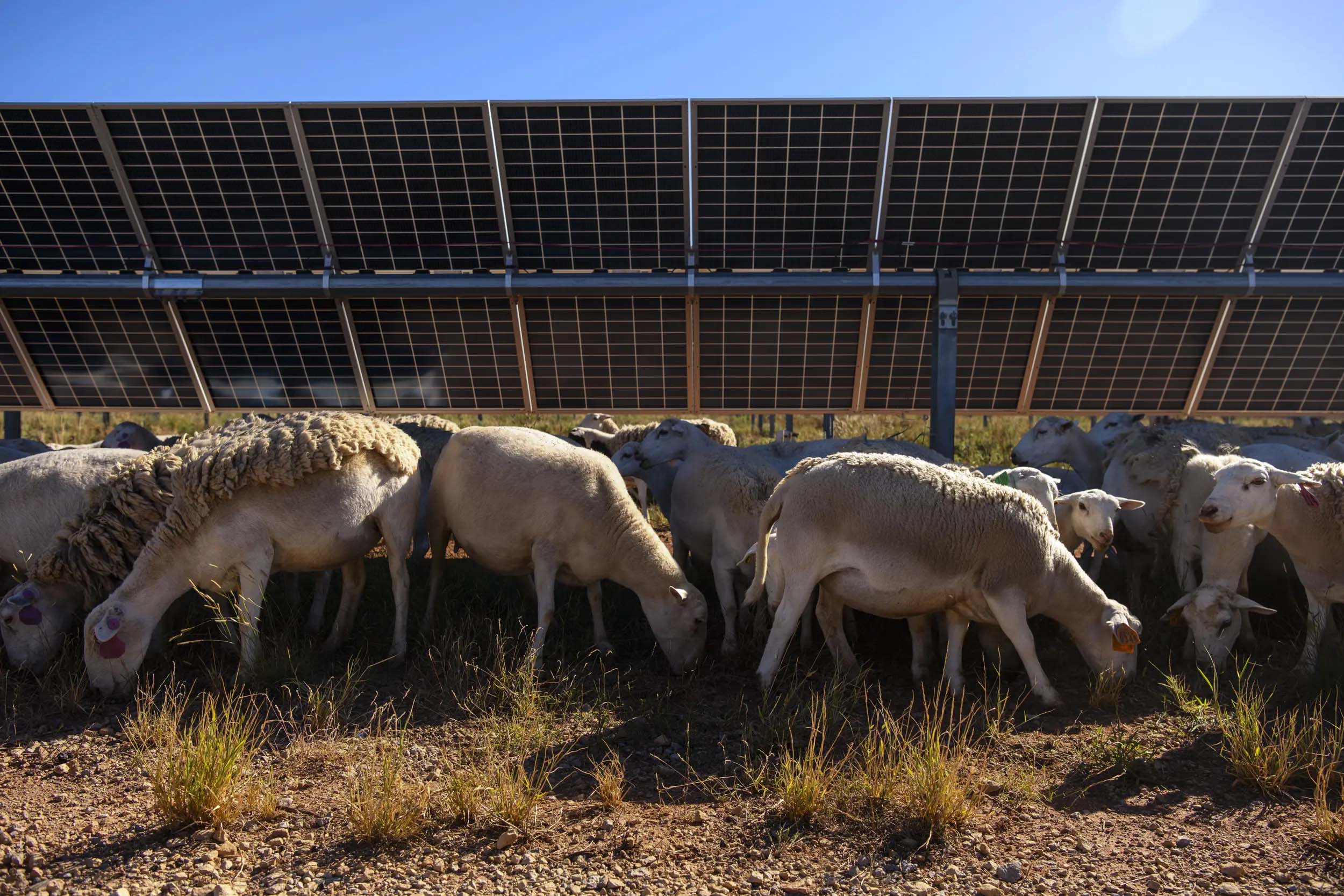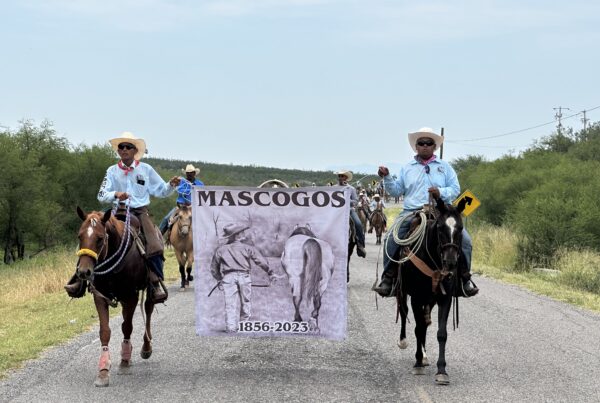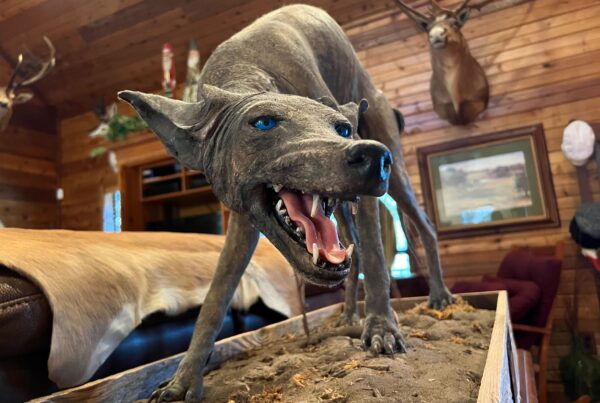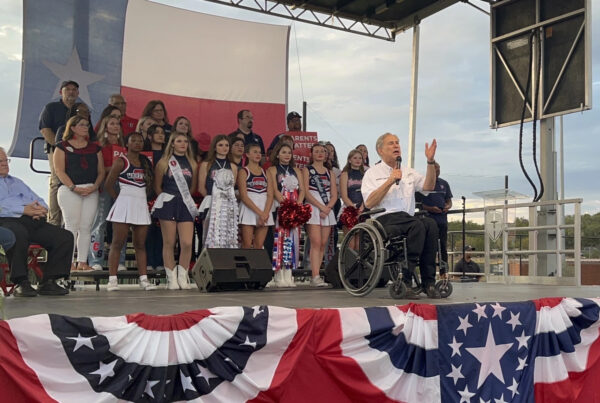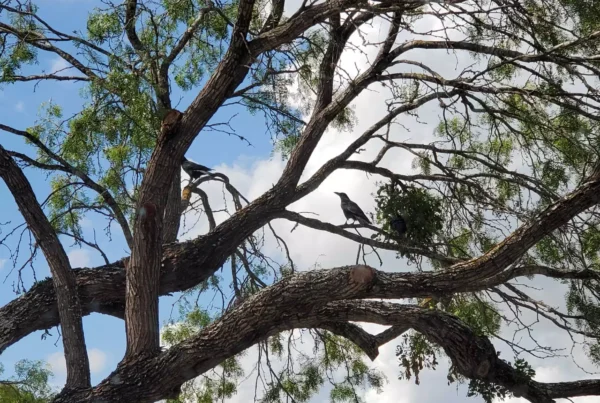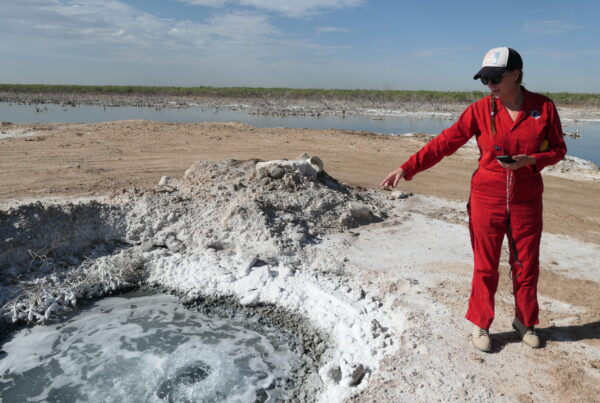From The Texas Tribune:
HASKELL COUNTY — Landon Terry steered the utility vehicle down the solar farm’s dirt road. The glittering panels were tilted almost vertically, blocking his view of the horizon. But the cowboy-turned-farmer knew he was close to his target when he saw fresh poop on the road.
“I have to holler,” Terry, 44, said as he parked the vehicle and hopped out.
“Woo—ooh!” Terry shouted.
His voice rang through the sunny morning. Terry waited. Along with his hard hat and protective sunglasses, he wore a button-down shirt, jeans and a silver belt buckle decorated with his cattle brand.
Then came the response.
“Baa.”
“Now we know where to go,” Terry said.
Terry jumped back into the Polaris Ranger and drove until he saw some of the 277 sheep in the pasture. A beige and black mixture of breeds such as Dorper, Katahdin and St. Croix, the sheep graze on native grasses, filling their bellies and keeping the vegetation low so it doesn’t shade the solar panels.
The practice of using land for both agriculture and solar power generation, known as agrivoltaics, is becoming increasingly common in Texas and nationwide. It can mean growing flowers for butterflies and bees, planting food crops around the solar panels or raising sheep for meat.
Experimenting with agrivoltaics took off as the number of industrial-scale solar farms skyrocketed in recent years in Texas. The state produces more solar power than any other except California. And although the panels emit no pollution, they are often built on former agricultural land, which can create friction in ranching and farming communities.
Agrivoltaics could help solar companies win over opponents who want to see the land’s former use maintained. The sheep burp methane, a greenhouse gas, but they don’t pollute like a diesel mower, can be more economical and are able to reach the hard-to-get spots around poles and wires without causing damage.
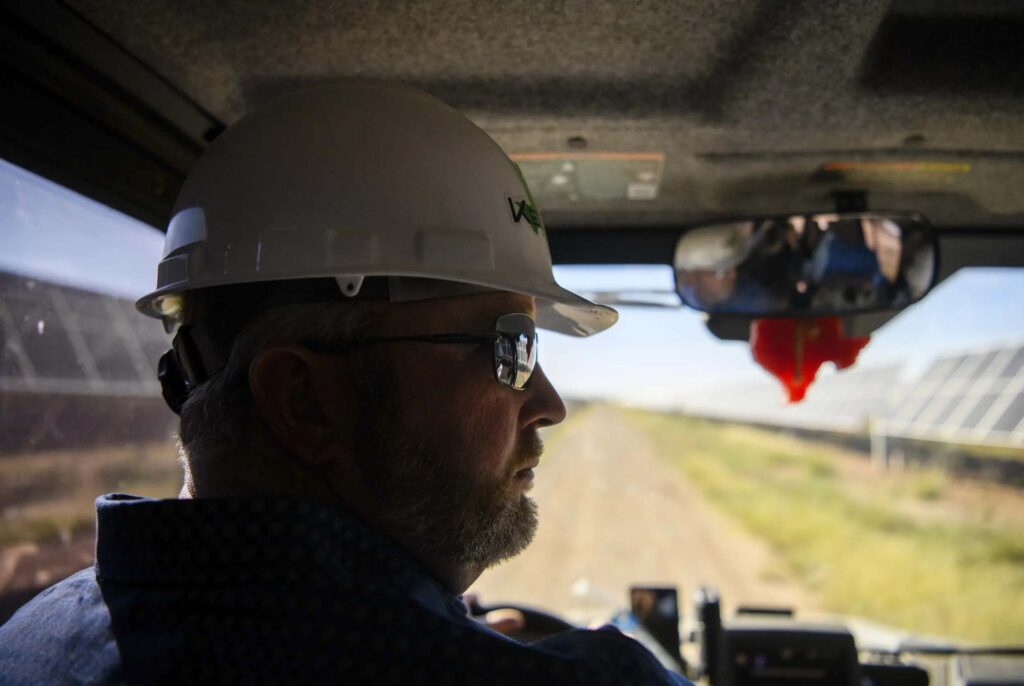
Landon Terry uses an all-terrain vehicle to search for his flock of sheep. The state produces more solar power than any other except California.
Trace Thomas for The Texas Tribune
The marriage of renewable energy and agriculture is also creating jobs for people such as Terry, who cares for the sheep on about a third of this 1,800-acre solar farm when he’s not farming cotton.
Terry grew up on a nearby cattle ranch where his dad worked. As a kid, Terry raised his own animals too, learning to spot a sick one’s runny nose or eyes. He jokes that he’s been riding horses since he was in his mother’s womb.
Before the company Enel North America started to build the solar farm in 2020 in Haskell County — a rural area with an estimated 5,400 residents between Dallas-Fort Worth and Lubbock — Terry said he used to work cattle on that same land.
“We’re not losing anything,” Terry says. “We’re just doing it differently.”
A national trend
People began to explore in earnest how to blend solar power generation and agriculture 12 to 15 years ago as solar technology became less expensive, said Jordan Macknick, lead energy-water-land analyst for the National Renewable Energy Laboratory. Interest in agrivoltaics ticked up as developers built more solar farms, he said.
Generally, solar companies lease land for a few decades. They need between five and 10 acres to generate one megawatt of power, according to an industry group. That’s enough to power about 200 Texas homes during periods of high demand.
“Every single square inch of land is owned by, cherished, protected by someone,” Macknick said. “People want to find a way in which we can make good use of the land.”
Macknick’s group at the federal research agency has mapped 383 sites in the country where solar companies added an agricultural use. Some states offer financial incentives for agrivoltaic projects or give them priority to connect to the grid, Macknick said. Texas electricity regulators don’t.
In an interview, Texas Agriculture Commissioner Sid Miller said he would like to see solar companies mount their panels high enough so cattle could graze under them or machinery could be used to plant crops like wheat and hay. The state has lost more than 2 million acres of agricultural land over the last 25 years, he said.
Farm land attracts solar developers because it tends to be flat, sunny and clear, said Samantha Levy, conservation and climate policy manager for the American Farmland Trust, which aims to conserve farmland. If a solar project is built on farmland, the Trust advocates for building it in a way that allows the land to go back into agricultural production later, or to stay in production after solar panels are installed.
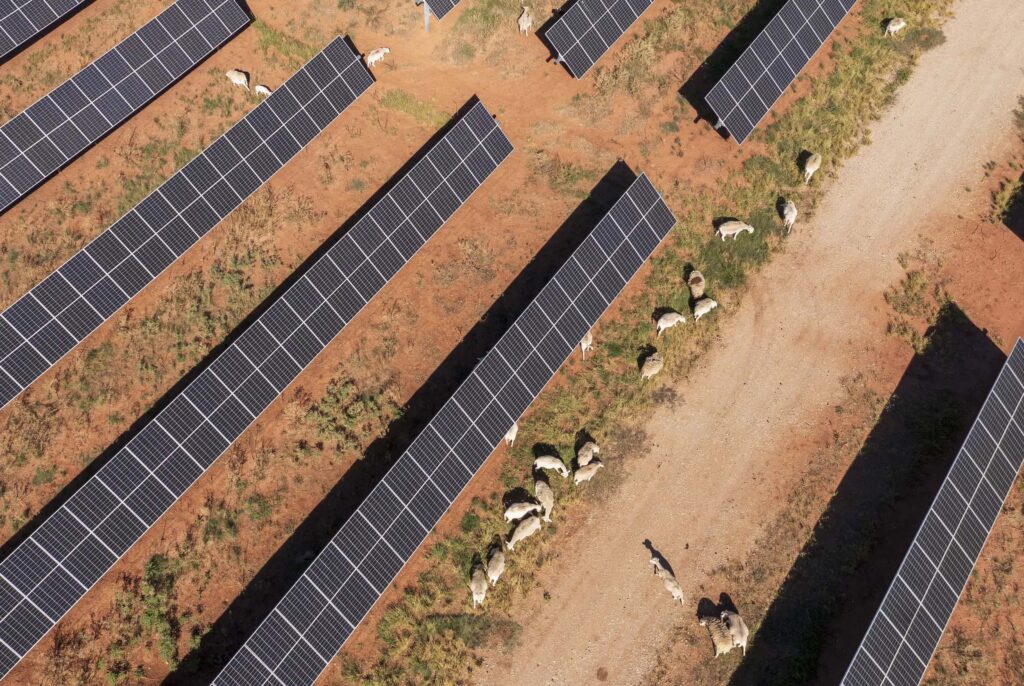
Agrivoltaics, the blending of renewable energy and agriculture, is becoming increasingly common in Texas and nationwide.
Trace Thomas for The Texas Tribune
“We recognize that decarbonization is important, and that climate change is impacting farmers and their bottom lines already,” Levy said. “If done well, solar can contribute to supporting farm viability.”
Amanda Stoffels, 44, and her husband were living their dream when they married, bought a farm in Ellis County, south of Dallas, and started raising cattle in addition to their day jobs, hers in education and his for the city of Grapevine. Then they signed a lease agreement with San Francisco-based solar project developer Lightsource bp, a joint venture that includes oil giant BP, and the money allowed her to quit her job and focus on her kids.
They thought the arrival of the solar facility meant giving up on agriculture, at least for the moment. Stoffels recalled crying in a field as they took down their fencing.
Then they talked to a neighbor who raised sheep and also agreed to lease his land for solar. Intrigued, Stoffels bought “Storey’s Guide to Raising Sheep” at a Tractor Supply store and read it every morning after her quiet time with the Bible. Stoffels now cares for hundreds of sheep that graze on part of the solar project’s 1,350 acres.
“We didn’t want to walk away if we didn’t have to,” Stoffels said. “We still get to be a part of renewable energy, we still get to be a part of the modern world, and yet at the same time we are still a part of the ancient practice of agriculture and grazing sheep.”
‘Fat and happy’
In Haskell County, Terry has been grazing sheep since March. Normally he arrives at daybreak when the panels are flat to the sky, and the sheep surround him like a cloud. He counts the animals, checks they have water and makes sure they’re healthy, even the standoffish ones he calls the “elite eight.” He picks up big clumps of wool they shed.
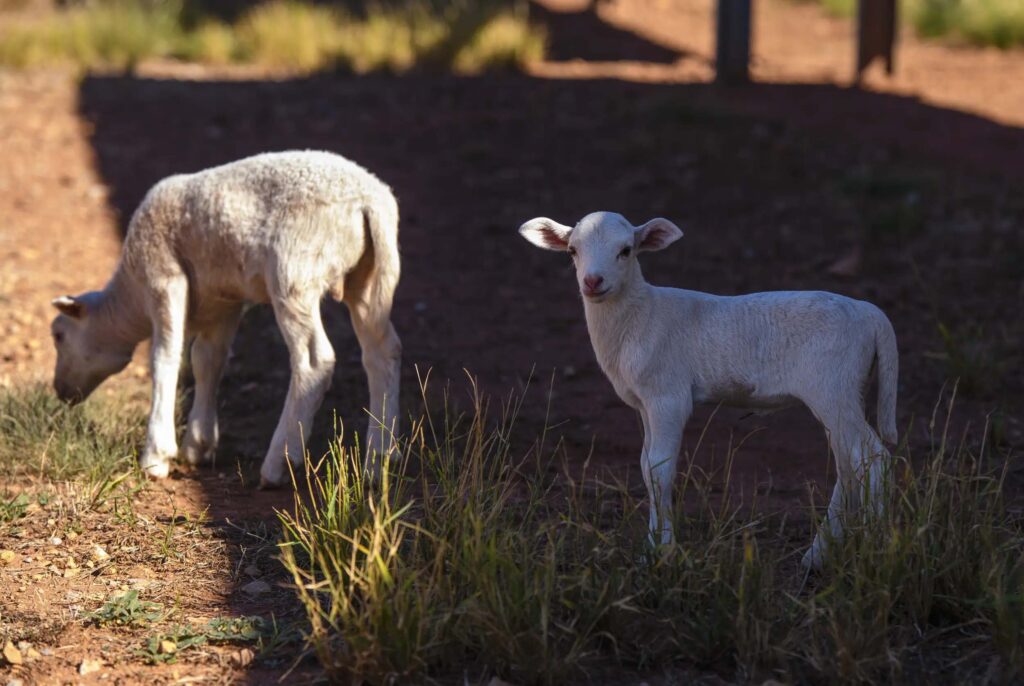
The sheep at Enel North America’s solar farm burp methane, a greenhouse gas, but they don’t pollute like a diesel mower, can be more economical than mowing and are able to reach the hard-to-get spots around poles and wires without causing damage.
Trace Thomas for The Texas Tribune
Terry works for Landon Kerby, the lead shepherd for KerTec, a land management company he runs outside Lubbock with his brothers. The company also owns the sheep.
The Kerby family grew up around livestock in the small city of Muleshoe, northwest of Lubbock near the New Mexico border. The brothers raised animals as kids; they taught their kids the same. Landon and his brother Rhett studied agronomy at Texas Tech; Rhett went on to get a masters in soil science from Iowa State.
They saw themselves continuing what generations of their family did: looking after the land.
KerTec launched in 2014 and focused in part on figuring out which plants to grow at commercial sites and how to maintain them for industries such as oil and gas and wind. Enel North America, a renewable energy company based in Massachusetts, was among the first solar developers to ask them about grazing sheep to manage the native grasses planted at their facility in Haskell County.
“It just makes sense,” Landon Kerby said.
“The grass has value as feed,” Rhett Kerby chimed in, “and so mowing equates to a lot of waste of feed value.”
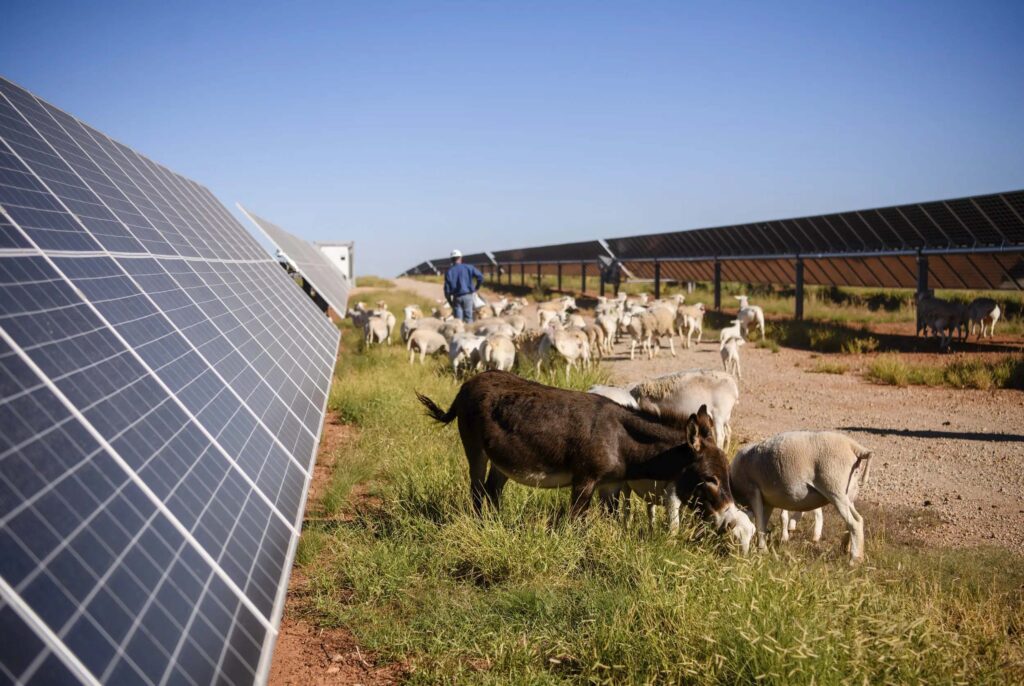
Pete the donkey protects the flock from coyotes as they rotate through almost 600 of the solar project’s 1,800 acres.
Trace Thomas for The Texas Tribune
Enel already grazed sheep on its solar sites in Minnesota, which Jesse Puckett, the company’s director of sustainability projects and community affairs, said fit the company’s mission to be environmentally friendly and make a positive impact in the community. Enel’s site manager, Kyle Brown, estimates the company saved $115,000 in mowing costs in the first seven months.
Terry aims to keep the sheep “fat and happy,” he said. Heaving a 50-pound bag of feed on his shoulder, Terry walked past the solar panels and scooped pellets onto the earth with his hands. “Cake,” Terry called it.
The sheep hurried over, bobbing their heads under the solar panels.
A few of the males could be used for breeding; most will be taken to a male-only site to graze until they’re sold for meat. The females will keep eating grass and birthing lambs. They nap in the panels’ shade, push grass seeds into the ground with their hooves and poop nutrients back onto the soil. A donkey named Pete helps protect them from coyotes.
“This is all an ecosystem,” Terry said. “You just have to think about it that way”


